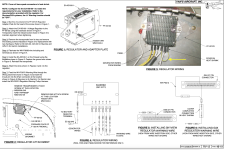EDIT3: We solved it! Problem was a bad connection at the VR. Took forever to find and a minute to fix.
Hi everyone,
I've got a new-to-me 2015 RV12 with a 912ULS that has about pushed me to my breaking point. I won't get into all the mistakes I made as a first-time aircraft buyer, but after many months and thousands of dollars I finally got it running well... and now it's grounded again.
The issue this time is negative amps and no charging on startup. The first time it happened we were getting around -6 amps even during the runup, and "solved" it by cleaning up the the firewall forward connector on the control module behind the Dynon with a little deoxit and dielectric grease.
A few flights later I started getting around -2 to -4 amps after startup, but it would start to charge again once I added higher RPM for the runup.
Then it progressed to where I had to run 4000+ RPM for a considerable length of time to get it to charge.
At this point I decided to bite the bullet and get a new voltage regulator (B&C). The first time we started it up with the new regulator it was charging perfectly! Then the second time... nothing.
Now we're at the point where it won't charge no matter what.
The latest thing we tried was replacing the connector housing and all the connectors to the VR, but that hasn't solved it.
Unfortunately I'm more of a fly it vs. fix it kinda guy, so I may need someone to explain to me like I'm 5. (My buddy is much more knowledgeable about this stuff than I am, so if I need an interpreter I'll pass it along to him.)
Help?
TIA.
EDIT: Forgot to mention we've tested the battery and that does not seem to be the problem. Takes and holds a charge just fine.
EDIT2: From my smarter friend: "The c pin has already been jumped from the b terminal so the fuse should not be the issue"
Hi everyone,
I've got a new-to-me 2015 RV12 with a 912ULS that has about pushed me to my breaking point. I won't get into all the mistakes I made as a first-time aircraft buyer, but after many months and thousands of dollars I finally got it running well... and now it's grounded again.
The issue this time is negative amps and no charging on startup. The first time it happened we were getting around -6 amps even during the runup, and "solved" it by cleaning up the the firewall forward connector on the control module behind the Dynon with a little deoxit and dielectric grease.
A few flights later I started getting around -2 to -4 amps after startup, but it would start to charge again once I added higher RPM for the runup.
Then it progressed to where I had to run 4000+ RPM for a considerable length of time to get it to charge.
At this point I decided to bite the bullet and get a new voltage regulator (B&C). The first time we started it up with the new regulator it was charging perfectly! Then the second time... nothing.
Now we're at the point where it won't charge no matter what.
The latest thing we tried was replacing the connector housing and all the connectors to the VR, but that hasn't solved it.
Unfortunately I'm more of a fly it vs. fix it kinda guy, so I may need someone to explain to me like I'm 5. (My buddy is much more knowledgeable about this stuff than I am, so if I need an interpreter I'll pass it along to him.)
Help?
TIA.
EDIT: Forgot to mention we've tested the battery and that does not seem to be the problem. Takes and holds a charge just fine.
EDIT2: From my smarter friend: "The c pin has already been jumped from the b terminal so the fuse should not be the issue"
Last edited:





